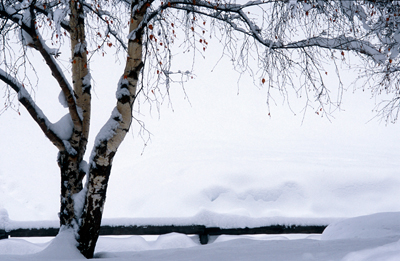Precise classification of the Earth's climatic zones is complex and dependent not only on temperature but also on precipitation, humidity, air-mass meteorology and the distribution of vegetation. However, for the sake of simplicity, a travel photographer can summarize the zones as tropical, subtropical, temperate, tundra and polar.
For film, high levels of humidity are potentially the most damaging environmental hazard. Deterioration begins as soon as canisters or foil wrappers are opened, so leave them sealed as long as possible. In coastal areas of equatorial, tropical and subtropical regions humidity may approach 100%, and spores of fungus flourish. Mould and mildew grow rapidly in temperatures between 24C and 30C, feed on dead organic matter such as leather, paper or gelatine, and thrive in darkness. Exposure to humid air can be reduced by storing sensitized materials in sealed polythene bags containing large sachets of a desiccant such as silica gel. When saturated, silica gel can be dried out in an oven and reused. A disadvantage of this approach is that bags of powder tend to attract the attention of customs officials. It may therefore be best to offer the bags containing the chemical, together with a manufacturer's information sheet, for immediate inspection.
 Film also deteriorates rapidly at high temperatures, the damage revealing itself as a colour shift towards red. In direct sun, or in closed vehicles where the temperature may rise above 100C, films can be ruined in a matter of hours. Hot spots such as those found near the engines of vehicles, on bus floors and on beaches should also be avoided. Problems can be minimized by leaving bulk film stocks and exposed films at your accommodation whenever possible. Refrigeration can be used to lower storage temperature but remember that the relative humidity inside a refrigerator is usually high. It is therefore safer to seal refrigerated materials in plastic containers containing desiccant.
Film also deteriorates rapidly at high temperatures, the damage revealing itself as a colour shift towards red. In direct sun, or in closed vehicles where the temperature may rise above 100C, films can be ruined in a matter of hours. Hot spots such as those found near the engines of vehicles, on bus floors and on beaches should also be avoided. Problems can be minimized by leaving bulk film stocks and exposed films at your accommodation whenever possible. Refrigeration can be used to lower storage temperature but remember that the relative humidity inside a refrigerator is usually high. It is therefore safer to seal refrigerated materials in plastic containers containing desiccant.
When photographic equipment and film are taken from a refrigerator or an air-conditioned room into a warm humid atmosphere, condensation may form on cool surfaces below the dew point of the surrounding air. A warm-up time of perhaps 10 or 20 minutes should therefore be allowed before taking cameras and films out of their protective cases. A similar approach should be adopted when taking photographic gear from a cold climate into a warm room.
Cold climates, such as those found at high altitudes, at polar latitudes or in deserts at night, present a different set of problems. Below -20C the metal surfaces of a camera or tripod may stick to face or hands and cause damage to the skin. Tripod legs can be sheathed or insulated with lengths of foam plastic, such as "tripads", to avoid this problem. Film, if used, goes brittle at low temperatures and therefore splits more readily than at room temperature. Cold and dry conditions also promote static discharge which marks film with blue streaks. The incidence of both problems can be reduced by rewinding film slowly. Batteries are also affected by low temperatures. Alkaline cells perform poorly below freezing point, and may fail completely at lower temperatures. Nickel cadmium (Nicad) varieties are better in this respect, but lithium cells typically found in digital cameras perform well down to -20C or below. Cold-weather battery packs are useful for extreme conditions. They can be kept warm in a pocket or under clothing, and are connected to the equipment they power via a long cord. A final consideration relevant to cold climates is to avoid breathing condensation into the open back of a film camera.
Day-to-day weather is of course also important. Average conditions are not always prevalent and uncharacteristic weather can soon change carefully prepared plans. I have experienced a hurricane in Hawaii, tropical storms in the Maldives and torrential rain in Alice Springs. It pays to keep schedules as flexible as possible and plan for an extra day or two in important locations.






